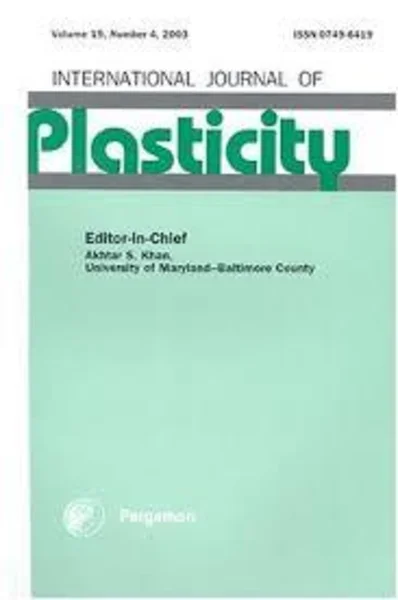-
an elasto-plastic damage constitutive theory and its prediction of evolution of subsequent yield surfaces and elastic constants
جزئیات بیشتر مقاله- تاریخ ارائه: 1390/01/01
- تاریخ انتشار در تی پی بین: 1390/01/01
- تعداد بازدید: 754
- تعداد پرسش و پاسخ ها: 0
- شماره تماس دبیرخانه رویداد: -
based on pair functional potentials, cauchy–born rule and slip mechanism, a material model assembling with spring-bundle components, a cubage component and slip components is established to describe the elasto-plastic damage constitutive relation under finite deformation. the expansion/shrink, translation and distortion of yield surfaces can be calculated based on the hardening rule and bauschinger effect defined on the slip component level. both kinematic and isotropic hardening are included. numerical simulations and predictions under tension, torsion, and combined tension–torsion proportional/non-proportional loading are performed to obtain the evolution of subsequent yield surfaces and elastic constants and compare with two sets of experimental data in literature, one for a very low work hardening aluminum alloy al 6061-t6511, and another for a very high work hardening aluminum alloy annealed 1100 al. the feature of the yield surface in shape change, which presents a sharp front accompanied by a blunt rear under proportional loading, is described by the latent hardening and bauschinger effect of slip components. further, the evolution law of subsequent yield surfaces under different proportional loading paths is investigated in terms of their equivalence. the numerical simulations under non-proportional loading conditions for annealed 1100 al are performed, and the subsequent yield surfaces exhibit mixed cross effect because the kinematic hardening and isotropic hardening follow different evolution tendency when loading path changes. the results of non-proportional loading demonstrate that the present model has the ability to address the issue of complex loading due to the introduction of state variables on slip components. moreover, as an elasto-plastic damage constitutive model, the present model can also reflect the variation of elastic constants through damage defined on the spring-bundle components.
مقالات جدیدترین رویدادها
-
استفاده از تحلیل اهمیت-عملکرد در ارائه الگوی مدیریت خلاقیت سازمانی و ارائه راهکار جهت بهبود
-
بررسی تاثیر ارزش وجوه نقد مازاد بر ساختار سرمایه شرکت های پذیرفته شده در بورس اوراق بهادار تهران
-
بررسی تأثیر سطح افشای ریسک بر قرارداد بدهی شرکت های پذیرفته شده در بورس اوراق بهادار تهران
-
بررسی تأثیر رتبه بندی اعتباری مبتنی بر مدل امتیاز بازار نوظهور بر نقد شوندگی سهام با تأکید بر خصوصی سازی شرکت ها
-
تأثیر آمیخته بازاریابی پوشاک ایرانی بر تصویر ذهنی مشتری پوشاک ایرانی (هاکوپیان)
-
معرفی و مقایسه روش های تعیین سرفاصله در حمل و نقل همگانی
-
چگونگی ایفای نقش بانک مرکزی در بازارهای ارز و پول
-
تحلیل پایداری قطار شهری شیراز با استفاده از نرم افزار twofs و مقایسه با روابط تجربی
-
natural convection from inclined plates to gases and liquids when both sides are uniformly heated at the same temperature
-
effect of near- field ground motions on the stability of embankment dams
مقالات جدیدترین ژورنال ها
-
مدیریت و بررسی افسردگی دانش آموزان دختر مقطع متوسطه دوم در دروان کرونا در شهرستان دزفول
-
مدیریت و بررسی خرد سیاسی در اندیشه ی فردوسی در ادب ایران
-
واکاوی و مدیریت توصیفی قلمدان(جاکلیدی)ضریح در موزه آستان قدس رضوی
-
بررسی تاثیر خلاقیت، دانش و انگیزه کارکنان بر پیشنهادات نوآورانه کارکنان ( مورد مطالعه: هتل های 3 و 4 ستاره استان کرمان)
-
بررسی تاثیر کیفیت سیستم های اطلاعاتی بر تصمیم گیری موفق در شرکتهای تولیدی استان اصفهان (مورد مطالعه: مدیران شرکتهای تولیدی استان اصفهان)
-
بررسی تاثیر چابکی سازمانی و خلاقیت سازمانی بر عملکرد شغلی کارکنان بانک توسعه صادرات ایران
-
اصطلاحات نجومی و بازتاب آن در شعر برخی از شاعران
-
«فمنیسم پسااستعماری و جنبش متقدم زنان در ایران» دیگری سازی و مناسبات سلطه
-
مدلی برای تحقق اهداف اقتصاد مقاومتی در بیمارستان (مطالعه موردی: بیماران مبتلا به بیماری های خاص)
-
the study of electron-orbital properties of bipolar energy of complex (2,6-diaminopyridinium bis (4-hydroxy-pyridine-2,6,6-dicarboxylate) dihydrate chromate iii))) with alteration of ligands by computational methods




سوال خود را در مورد این مقاله مطرح نمایید :